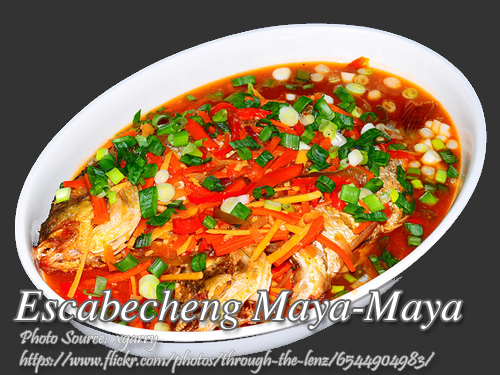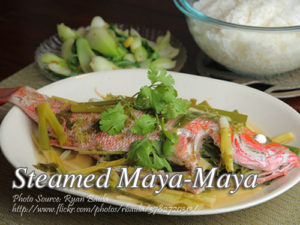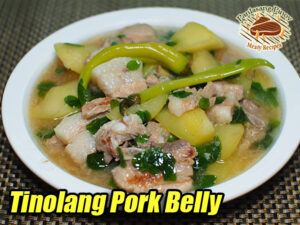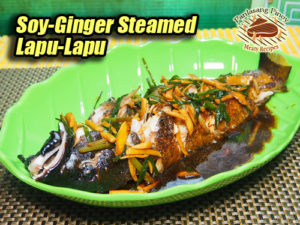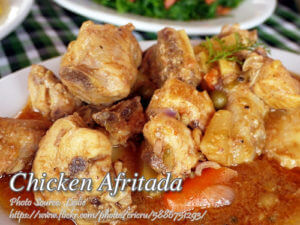Escabecheng maya maya is a delightfully tasty sweet and sour fish. This recipe I have here is fried maya-maya or red snapper fish poured with sweet and sour sauce and garnished with vegetables. Cooking this sweet sour fish is easy and ingredients are simple and can be bought readily in supermarkets.
But one ingredient that might not always available is the green or unripe papaya which makes this a unique Filipino escabeche dish. Aside from the usual sliced carrots, bell peppers, onion and ginger, this sweet sour fish is added with grated green papaya which reminds me of atchara, a sweet sour relish made from grated unripe papaya.
Escabecheng Maya Maya (Sweet and Sour Red Snapper)
If there’s one dish that always brings me back to my childhood kitchen in Cavite, it’s escabecheng maya maya. I remember my Tita Luz preparing this whenever we had special guests over, her hands skillfully working over the stove as the tangy-sweet aroma filled the house. It was one of her signature dishes, and I’ve since adopted her recipe with a few tweaks inspired by my Uncle Bert’s advice. He always swore by the magic of unripe papaya to give the sauce an extra Filipino touch.
Escabecheng Maya Maya is a Dish with a Filipino Heart
Escabeche has its roots in Spanish cuisine, but like many Filipino adaptations of foreign dishes, we made it our own. In the Philippines, escabecheng maya maya is a popular take on the classic sweet and sour fish. Unlike versions from other countries that may rely heavily on pineapple for their sweetness, this dish incorporates grated green papaya. It not only adds texture but also hints at the tangy freshness reminiscent of atchara, our beloved pickled papaya relish.
The key to a great escabeche is balancing flavors—the sweetness of sugar, the tanginess of vinegar, and the savory depth of fried fish. The combination of vegetables like carrots and bell peppers gives it a colorful presentation and a satisfying crunch. Every family, of course, has its version, and this recipe is inspired by my family’s love for combining vibrant flavors with sentimental ingredients.
Choosing and Preparing the Fish for Escabecheng Maya Maya
My cousin Mina always insists that the star of the dish should be a perfectly cooked maya maya. Red snapper is not only visually striking with its red scales, but it also has a mild flavor and firm texture that hold up well to frying and soaking in sauce. Uncle Bert once told me to season the fish generously with salt and pepper before frying to ensure it’s flavorful through and through.
Frying the fish until golden brown ensures a crispy skin that contrasts beautifully with the saucy topping. My Lola used to remind us to pat the fish dry with paper towels before frying. It prevents the oil from splattering and helps achieve that beautiful sear without steaming the fish.
Creating the Perfect Sweet and Sour Sauce
The magic of escabecheng maya maya lies in its sauce. Start by sautéing garlic, onions, and ginger until they release their aroma. This step not only builds flavor but also eliminates any raw pungency from the ingredients. My Tita Luz always said the secret to her sauce was the yellow ginger juice she squeezed fresh each time. It gave the sauce a sunny warmth that complemented the tanginess of the vinegar.
Adding red and green bell peppers, along with grated green papaya, not only makes the dish visually stunning but also contributes layers of texture. The bell peppers stay slightly crisp, while the papaya softens to meld with the sauce, creating a delightful medley of flavors and textures.
The Role of Grated Green Papaya
Grated green papaya is what sets Filipino escabeche apart. It’s not a common ingredient in other versions of sweet and sour fish, making this dish uniquely Pinoy. Its inclusion reminds me of helping my sister, Lila, prepare atchara during fiesta season. The slight tang and crunch of the papaya balance the richness of the fried fish and the sweetness of the sauce.
Putting It All Together
Once the sauce has simmered and the flavors have melded, it’s time to assemble the dish. Arrange the fried maya maya on a large oval platter and carefully pour the sauce over the top, letting it cascade over the fish. My mom would always sprinkle chopped scallions on top as a garnish, though that’s optional. The dish looks like a vibrant centerpiece, ready to wow your family or guests.
Food for Thought
Escabeche is more than just a dish; it’s a culinary bridge between our Spanish heritage and Filipino ingenuity. The technique of frying the fish first ensures it doesn’t turn mushy when coated in sauce, a method passed down through generations. Using green papaya is a nod to our resourcefulness, showcasing how we adapt local ingredients to suit our palate and environment.
Cooking escabecheng maya maya isn’t just about following a recipe. It’s about preserving the stories, the shared meals, and the laughter that come with it. Whenever I make this dish, I think of my family and the simple joys of gathering around a table with loved ones. So whether you’re a beginner in the kitchen or someone longing for a taste of home, give this recipe a try. It’s more than a meal; it’s a memory waiting to happen.
How to Cook Escabecheng Maya-Maya
Ingredients
For the fish
- 1 1/2 kilo whole maya-maya
- salt and pepper to taste
- cooking oil for frying
For the sweet sour sauce
- 3 cloves garlic minced
- 1 pc onion chopped
- 20 grams ginger sliced or julienne
- 2 small red and green bell pepper julienne
- 10 grams yellow ginger juiced
- 1 cup vinegar
- 5 Tbsp. sugar
- 1 cup grated green papaya
- Salt and pepper to taste
- chopped scallion for garnishing optional
Instructions
How to cook Escabecheng Maya-Maya
- Season fish with salt and pepper. Fry fish in oil and keep warm.
- Saute garlic, onion and ginger. Stir for 2 minutes.
- Add red and green bell pepper, yellow ginger juice, vinegar, sugar and grated green papaya.
- Simmer for 5 minutes. Season with salt and pepper.
- Arrange fish on an oval platter. Pour sauce over it. Garnish with scallion (optional). Serve hot.
Notes
Cooking Tips:
Use the Right Pan for Frying
When frying maya maya, choose a heavy-bottomed pan or skillet to ensure even heat distribution. This prevents hot spots that can cause uneven cooking or burning of the fish. A properly heated pan also helps the fish develop a golden crust while keeping the flesh moist and tender.Simmer the Sauce Gently
To achieve a smooth and balanced sweet and sour sauce, simmer it over low to medium heat. This allows the sugar to dissolve fully and the flavors of the vinegar, ginger, and papaya to meld together. Avoid boiling the sauce vigorously, as this can cause it to break or become overly tangy.Let the Fried Fish Rest Before Adding Sauce
After frying the fish, let it rest for a few minutes to allow the crispy skin to set. This helps prevent the fish from becoming soggy when the sauce is poured over it. A rested fish also absorbs the sauce better, ensuring each bite is flavorful without losing texture.
